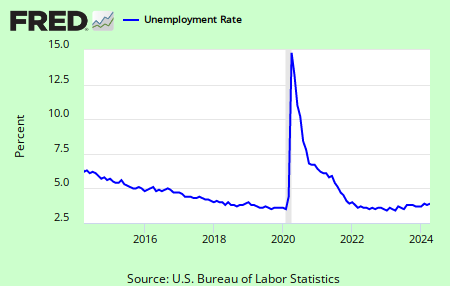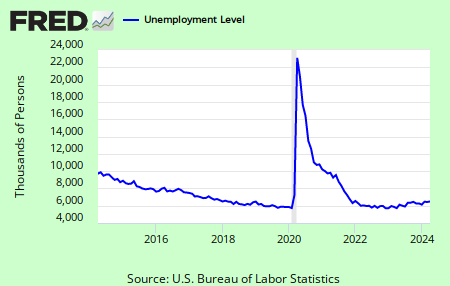Nonfarm payroll employment continued to decline in July (-247,000),
and the unemployment rate was little changed at 9.4 percent, the U.S.
Bureau of Labor Statistics reported today. The average monthly job
loss for May through July (-331,000) was about half the average
decline for November through April (-645,000). In July, job losses
continued in many of the major industry sectors.
The change in total nonfarm payroll employment for May was revised
from -322,000 to -303,000, and the change for June was revised from -
467,000 to -443,000.
Subscribe to EF Hutton via Email
THE EMPLOYMENT SITUATION -- JULY 2009
Nonfarm payroll employment continued to decline in July (-247,000),
and the unemployment rate was little changed at 9.4 percent, the U.S.
Bureau of Labor Statistics reported today. The average monthly job
loss for May through July (-331,000) was about half the average
decline for November through April (-645,000). In July, job losses
continued in many of the major industry sectors.
Household Survey Data
In July, the number of unemployed persons was 14.5 million. The
unemployment rate was 9.4 percent, little changed for the second
consecutive month. (See table A-1.)
Among the major worker groups, unemployment rates for adult men (9.8
percent), adult women (7.5 percent), teenagers (23.8 percent), whites
(8.6 percent), blacks (14.5 percent), and Hispanics (12.3 percent)
were little changed in July. The unemployment rate for Asians was 8.3
percent, not seasonally adjusted. (See tables A-1, A-2, and A-3.)
The number of long-term unemployed (those jobless for 27 weeks or more)
rose by 584,000 over the month to 5.0 million. In July, 1 in 3 unemploy-
ed persons were jobless for 27 weeks or more. (See table A-9.)
The civilian labor force participation rate declined by 0.2 percentage
point in July to 65.5 percent. The employment-population ratio, at 59.4
percent, was little changed over the month but has declined by 3.3 per-
centage points since the recession began in December 2007. (See
table A-1.)
The number of persons working part time for economic reasons (sometimes
referred to as involuntary part-time workers) was little changed in July
at 8.8 million. The number of such workers rose sharply in the fall and
winter but has been little changed for 4 consecutive months.
(See table A-5.)
About 2.3 million persons were marginally attached to the labor force
in July, 709,000 more than a year earlier. (The data are not seasonally
adjusted.) These individuals, who were not in the labor force, wanted
and were available for work and had looked for a job sometime in the
prior 12 months. They were not counted as unemployed because they had
not searched for work in the 4 weeks preceding the survey. (See
table A-13.)
Among the marginally attached, there were 796,000 discouraged workers
in July, up by 335,000 over the past 12 months. (The data are not
seasonally adjusted.) Discouraged workers are persons not currently
looking for work because they believe no jobs are available for them.
The other 1.5 million persons marginally attached to the labor force
in July had not searched for work in the 4 weeks preceding the survey
for reasons such as school attendance or family responsibilities.
Establishment Survey Data
Total nonfarm payroll employment declined by 247,000 in July. From May
to July, job losses averaged 331,000 per month, compared with losses
averaging 645,000 per month from November to April. Since December
2007, payroll employment has fallen by 6.7 million. (See table B-1.)
Employment in construction declined by 76,000 in July, about in line
with the average for the past 3 months (-73,000). Employment had de-
creased by 117,000 a month on average from November to April.
Manufacturing employment fell by 52,000 in July and has declined by
2.0 million since the recession began. In motor vehicles and parts,
fewer workers than usual were laid off in July for seasonal retool-
ing. As a result, the estimate of employment for the industry rose
by 28,000 after seasonal adjustment. In large part, July's seasonally-
adjusted increase reflects the fact that previous job cuts had been
so extensive that there were fewer workers to lay off during the sea-
sonal shutdown. Elsewhere in manufacturing, several industries con-
tinued to lose jobs in July, including machinery (-15,000) and fabri-
cated metal products (-14,000).
In July, retail trade employment declined by 44,000. Job losses in the
industry had averaged 27,000 per month over the prior 3 months. Em-
ployment in wholesale trade fell by 19,000 in July, with the majority
of the decline occurring among durable goods wholesalers.
Employment in professional and business services continued to trend
down in July (-38,000); the industry has shed 1.5 million jobs since
the start of the recession. Within professional and business services,
employment in the temporary help industry edged down in July. While
temporary help has lost 844,000 jobs since the recession began, the
declines have lessened substantially over the past 3 months.
Transportation and warehousing lost 22,000 jobs in July. Since May,
the average monthly job loss was half the average monthly decline for
November through April (-17,000 versus -34,000).
Financial activities employment continued to trend down in July
(-13,000). The average monthly decline for this industry was 23,000
over the past 3 months compared with 46,000 per month from November
through April. Since the start of the recession, the financial acti-
vities industry has lost 501,000 jobs. Employment in information de-
clined by 16,000 in July, including losses in publishing and telecom-
munications.
Health care employment increased by 20,000 in July, about in line
with the average monthly gain for the first half of this year but
down from an average monthly increase of 30,000 during 2008. Employ-
ment in lei-sure and hospitality has been little changed over the
past 3 months.
In July, the average workweek of production and nonsupervisory work-
ers on private nonfarm payrolls edged up by 0.1 hour to 33.1 hours.
The manufacturing workweek increased by 0.3 hour to 39.8 hours. Fac-
tory overtime was unchanged at 2.9 hours. (See table B-2.)
In July, average hourly earnings of production and nonsupervisory
workers on private nonfarm payrolls rose by 3 cents, or 0.2 percent,
to $18.56. Over the past 12 months, average hourly earnings have
increased by 2.5 percent, while average weekly earnings have risen
by only 1.0 percent due to declines in the average workweek. (See
table B-3.)
The change in total nonfarm payroll employment for May was revised
from -322,000 to -303,000, and the change for June was revised from -
467,000 to -443,000.
 Bob DeMarco is a citizen journalist and twenty year Wall Street veteran. Bob has written more than 500 articles with more than 11,000 links to his work on the Internet. Content from All American Investor has been syndicated on Reuters, the Wall Street Journal, Fox News, Pluck, Blog Critics, and a growing list of newspaper websites. Bob is actively seeking syndication and writing assignments. Bob DeMarco is a citizen journalist and twenty year Wall Street veteran. Bob has written more than 500 articles with more than 11,000 links to his work on the Internet. Content from All American Investor has been syndicated on Reuters, the Wall Street Journal, Fox News, Pluck, Blog Critics, and a growing list of newspaper websites. Bob is actively seeking syndication and writing assignments. |
Follow E F Hutton on Twitter
Kindle: Amazon's 6"  Wireless Reading Device
Wireless Reading Device







